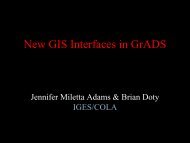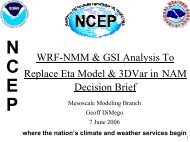through the end of the data set in spring 2002, and passive microwave thereafter. Thosegrids are available 1-3 times per week throughout the period when available.Concentrations were linearly interpolated between the observation dates, and thoseinterpolated values are used here, averaged on to the target 0.5 degree grid from thenative 2.55 km Mercator projection. For large lakes in Canada, the Canadian Ice Service[CIS, personal communication] analyses were used for all lakes which were analyzed(initially 34, in November, 1995, increasing to 137 by October, 2007) from November1995 through October 29, 2007 (start of CFSR processing). Again, concentrations werelinearly interpolated in time between observations. From October 30, 2007 to present,the concentrations are the operational <strong>NCEP</strong> passive microwave sea ice concentrationanalyses [Grumbine, 2010a].Large water bodies which may freeze, but which lie outside the domain analyzed inGSFC Ice [Cavalieri et al., 1996, updated 2007], in the period 1978-1996 were analyzedby proxy, as was done for portions of the North American Regional <strong>Reanalysis</strong>[Mesinger, et al., 2006]. Proxies were generated anew for this work as the domain wasmuch larger, and more data were now available. During the period 1 January 1997 - 30June 2006 (when both <strong>NCEP</strong> ice and GSFC ice were available), the <strong>NCEP</strong> ice analysiswas used to identify points (one by one) which lay inside the GSFC ice domain andwhich had high correlation to concentrations analyzed for points outside the GSFC icedomain -- but still inside the <strong>NCEP</strong> domain. This includes large lakes like Lake Ladogaand Lake Onega, as well as the Caspian Sea. Due to changes in SST sources for filteringsea ice concentration analyses, the Aral sea, Lakes Balkhash, Hulun Nur, and some otherscould not be consistently analyzed and were assigned zero ice concentration. This willbias surface heat fluxes high in periods where the real lake is ice covered. Some lakescannot be observed strictly by modern passive microwave due to land contaminationissues, and were assigned land flags in the reanalysis if no other data were available; thisincludes Lake Athabasca, Lake of the Woods, Lake Nipigon (outside the period of CISdata), Iliamna Lake, and Lake Vanern.- 34 -
For 1 Jan 1997-29 Feb 2000, the global ice concentration analysis was the <strong>NCEP</strong>operational ice analysis [Grumbine, 1996] (again, outside the Great Lakes and CanadianLakes). For 1 March 2000 to the 29 October 2007 the sea ice analysis is the newer <strong>NCEP</strong>sea ice analysis system [Grumbine, 2010a] applied to archived passive microwave datafor DMSP F-13, F-14, and F-15. <strong>The</strong> old <strong>NCEP</strong> system was based on the NASA Team1algorithm [Cavalieri 1992] as was the GSFC ice [Cavalieri et al. 1996, updated 2007].<strong>The</strong> newer system is based on the Team2 algorithm [Markus and Cavalieri, 2000]. In thenewer <strong>NCEP</strong> system [Grumbine 2010a], sea ice concentration for each day, for each(northern, southern) hemisphere, is computed by regression of the Stokes-like parameter(T85V 2 - T85H 2 ) 0.5 (where T85V is the 85 GHz brightness temperature at verticalpolarization, and T85H is likewise for the horizontal polarization) against the Team2-derived concentration -- for those points that are greater than 100 km from land, and arepoleward of 60 degrees latitude. <strong>The</strong> regression provides an unbiased estimator, and, dueto the small footprint of the 85 GHz channel, a higher resolution estimate -- permittinganalysis closer to the coast, and inside smaller lakes, than would otherwise be possiblewith the pure Team2 algorithm. This operational system used the SSMI instruments onDMSP F-13, F-14, and F-15 while those were all available. F-14 stopped providing datain October 2008. F-15 suffered progressively severe corruption of the 22 GHz channel(used for weather filtering, not for sea ice concentration computation) in late 2008 andwas removed from <strong>NCEP</strong> sea ice production 5 March, 2009. AMSRE was added to theoperational sea ice system 13 May 2009, using the AMSR-E Team2 algorithm withJanuary, 2009 tie points as described in Markus and Cavalieri [2009]. That date was,unfortunately, concurrent with a data flow outage from AMSRE and data corruption in F-13. This simultaneous failure degraded the quality of the sea ice analysis in May 2009.From June 2009 to present, sufficient data have been available for analysis. Februarythrough April was re-analyzed retrospectively using F-13 and AMSRE, so that the CFSRice is based on those even though AMSRE did not come in to the operational <strong>NCEP</strong> seaice analysis until May 13.- 35 -
- Page 2 and 3: ABSTRACTThe NCEP Climate Forecast S
- Page 4 and 5: 1. IntroductionThe first reanalysis
- Page 6 and 7: In this paper we only discuss globa
- Page 8 and 9: the reanalysis was halted to addres
- Page 10 and 11: online archive of data for reanalys
- Page 12 and 13: density MESONET data is included in
- Page 14 and 15: The 1B datasets were calibrated usi
- Page 16 and 17: MetOp is Europe's first polar-orbit
- Page 20 and 21: The third GSI feature enabled in th
- Page 22 and 23: the hydrostatic assumption. Soon af
- Page 24 and 25: esolution with 28 sigma layers in t
- Page 26 and 27: SW and LW radiations at one-hour in
- Page 28 and 29: SST data. The other uses AVHRR and
- Page 30 and 31: y Gent and McWilliams (1990; see al
- Page 32 and 33: from the Global Temperature-Salinit
- Page 36 and 37: The passive microwave weather filte
- Page 39 and 40: from the sea ice/ocean back to the
- Page 41 and 42: weight is assigned to the gauge ana
- Page 43 and 44: Stream 6: 1 Jan 1994 to 31 Mar 1999
- Page 45 and 46: in the mid 1990’s, the period whe
- Page 47: e due to a change over the oceans (
- Page 52 and 53: In Figure 49, we show the temporal
- Page 54 and 55: distributed in time and space. Desp
- Page 56 and 57: forecast model at a lower resolutio
- Page 58 and 59: Appendix A: AcronymsAER Atmospheric
- Page 60 and 61: ONPCMDIPIRATAPROFLRQBOQuikSCATR1R2R
- Page 62 and 63: TMP2M 2m air temperature 24 / 473TM
- Page 64 and 65: Appendix C: The Data AccessTo addre
- Page 66 and 67: Figure 26 shows the global total bi
- Page 68 and 69: Argo Science Team, 2001: The global
- Page 70 and 71: Compo, G.P., J.S. Whitaker, and P.D
- Page 72 and 73: ozone Mapping and Profiler Suite (O
- Page 75 and 76: Global Forecast System. Manuscript
- Page 77 and 78: and climate models. Atmos. Chem. Ph
- Page 79 and 80: performance Earth system modeling w
- Page 81 and 82: with mesoscale numerical weather pr
- Page 83 and 84: experiments using SSM/I wind speed
- Page 85 and 86:
Figure 21: Same as Figure 2, but fo
- Page 87 and 88:
Figure 45: The fit of 6-hour foreca
- Page 89 and 90:
Figure 1: Diagram illustrating CFSR
- Page 91 and 92:
Figure 3: Same as in Figure 2, but
- Page 93 and 94:
Figure 5: Same as in Figure 2, but
- Page 95 and 96:
Figure 7: Same as in Figure 2, but
- Page 97 and 98:
Figure 9: Same as in Figure 2, but
- Page 99 and 100:
Figure 11: Same as in Figure 2, but
- Page 101 and 102:
Figure 13: Same as in Figure 2, but
- Page 103 and 104:
Figure 15: Radiance instruments on
- Page 105 and 106:
Figure 17: Same as in Figure 16, bu
- Page 107 and 108:
Figure 19: Global average Tb first
- Page 109 and 110:
Figure 21: Same as in Figure 16, bu
- Page 111:
Figure 23: Comparisons of the SSU b
- Page 114 and 115:
Figure 26: The global total bias fo
- Page 116 and 117:
Figure 28: The yearly total of trop
- Page 118 and 119:
Figure 30: The vertical structure o
- Page 120 and 121:
Figure 32: The global number of tem
- Page 122 and 123:
Figure 34: The same as Figure 33, b
- Page 124 and 125:
Figure 36: Monthly mean Sea ice ext
- Page 126 and 127:
Figure 38: 2-meter volumetric soil
- Page 128 and 129:
Figure 40: Schematic of the executi
- Page 130 and 131:
Figure 42: Yearly averaged Southern
- Page 132 and 133:
Figure 44: Monthly mean hourly surf
- Page 134 and 135:
Figure 46: Global mean temperature
- Page 136 and 137:
Figure 48: Zonal mean total ozone d
- Page 138 and 139:
Figure 50: The subsurface temperatu
- Page 140 and 141:
Figure 52: Vertical profiles of the
- Page 142 and 143:
Figure 54: Zonal surface velocities
- Page 144 and 145:
ProgramPREVENTSACQCACAR_CQCCQCCQCVA
- Page 146:
Satellite Starting date Ending Date





